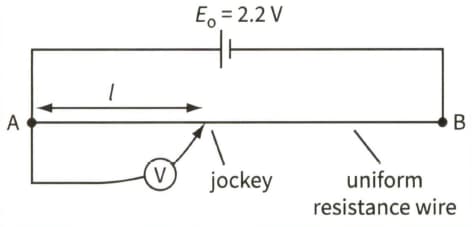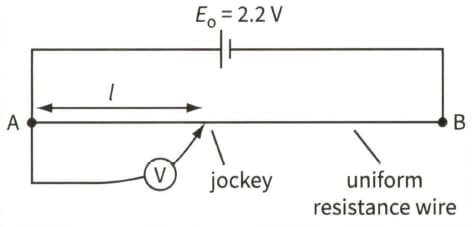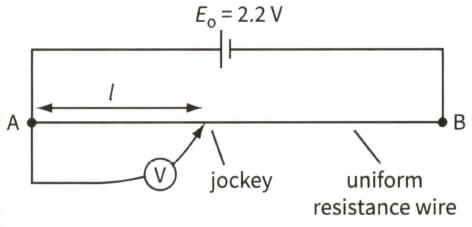David Sang and Graham Jones Solutions for Chapter: Practical Circuits, Exercise 9: EXAM-STYLE QUESTIONS
David Sang Physics Solutions for Exercise - David Sang and Graham Jones Solutions for Chapter: Practical Circuits, Exercise 9: EXAM-STYLE QUESTIONS
Attempt the practice questions on Chapter 11: Practical Circuits, Exercise 9: EXAM-STYLE QUESTIONS with hints and solutions to strengthen your understanding. Physics for Cambridge International AS & A Level Coursebook 3rd Edition Digital Access solutions are prepared by Experienced Embibe Experts.
Questions from David Sang and Graham Jones Solutions for Chapter: Practical Circuits, Exercise 9: EXAM-STYLE QUESTIONS with Hints & Solutions
This is a potentiometer circuit.

(a) (ii) State the readings on the voltmeter when the jockey is connected to A and when it is connected to B. (You may assume that the driver cell has negligible internal resistance.)
This is a potentiometer circuit.

Draw a circuit diagram to show how the potentiometer could be used to compare the e.m.f.s of two batteries.
This is a potentiometer circuit.

When a pair of resistors are connected in series with a battery, there is a current of current through the battery. When the same two resistors are connected in parallel and then connected across the battery, there is a current of through it. Calculate the e.m.f. and the internal resistance of the battery.
A potentiometer, which consists of a driving cell connected to a resistance wire of length , is used to compare the resistances of two resistors. Draw a diagram to show the circuits that are used to compare the two resistances.
A potentiometer, which consists of a driving cell connected to a resistance wire of length , is used to compare the resistances of two resistors. When resistor alone is tested the length of resistance wire for balance is . There is an uncertainty in measuring the beginning of the resistance wire of , and in establishing the balance point of a further . Determine the uncertainty in the balance length. When and are tested in series the balance length is . There are similar uncertainties in measuring this balance length.
A potentiometer, which consists of a driving cell connected to a resistance wire of length , is used to compare the resistances of two resistors. When resistor alone is tested the length of resistance wire for balance is . There is an uncertainty in measuring the beginning of the resistance wire of , and in establishing the balance point of a further . Calculate the ratio of
A potentiometer, which consists of a driving cell connected to a resistance wire of length , is used to compare the resistances of two resistors. When resistor alone is tested the length of resistance wire for balance is . There is an uncertainty in measuring the beginning of the resistance wire of , and in establishing the balance point of a further . Calculate the value of the ratio of .
A potentiometer, which consists of a driving cell connected to a resistance wire of length , is used to compare the resistances of two resistors.
(b) When resistor alone is tested the length of resistance wire for balance is . There is an uncertainty in measuring the beginning of the resistance wire of , and in establishing the balance point of a further .
(iv) Calculate the uncertainty in the value of the ratio .
